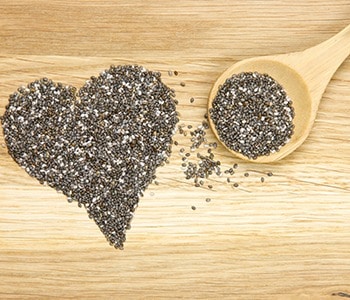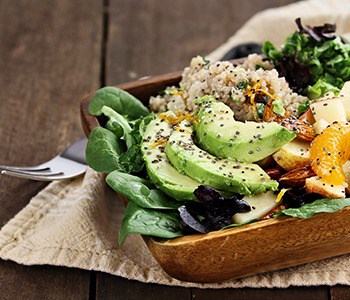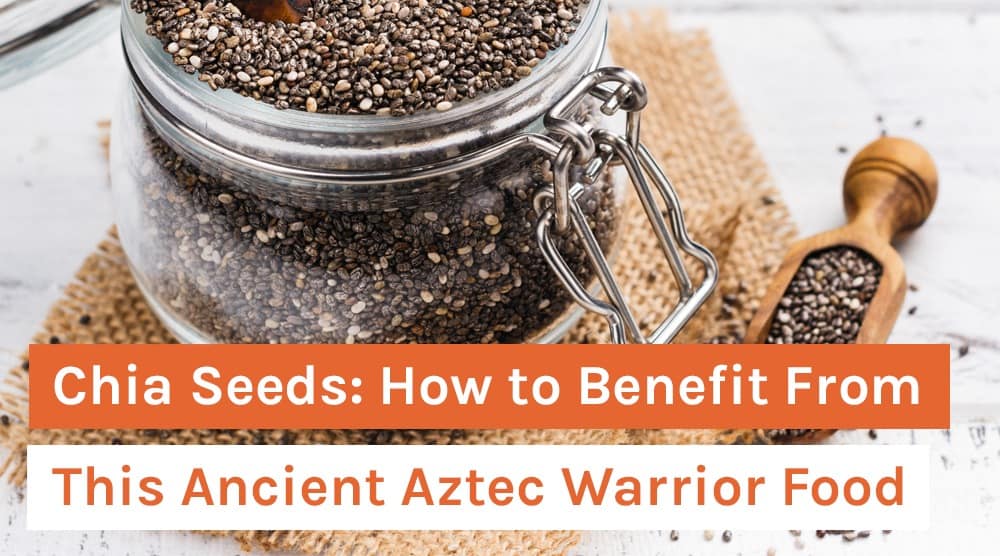Chia Seeds: How to Benefit From This Ancient Aztec Warrior Food
In a hurry? Click here to read the Article Summary...
Being so small and unassuming, they may not seem like much on the surface. But chia seeds (Salvia hispanica) are one of the most nutritionally-dense “superfoods” on the planet that many people are only just now discovering. If you’re someone who’s never tried them, you’ll probably want to change this as soon as possible for the benefit of your health.
Long before they were popularized as a decorative novelty in the 1990s with those little clay animals that grew grassy “fur” coats, chia seeds were a staple part of the ancient Mesoamerican diet. Unlike many other foods they represent a complete form of nutrition that doesn’t go rancid or spoil.
With their name translating as “strength” in the Mayan language, chia seeds were long believed to provide almost supernatural powers to the human frame. This is why many ancient warriors kept them close for energy and stamina during battle.
Ancient Aztec warriors are also said to have travelled long distances with only chia seeds in hand, knowing that this powerful superfood would sustain them through thick and thin.
Many ancient civilizations valued chia seeds so highly that they even offered them up as precious gifts to their gods. While most people today don’t think of chia seeds in spiritual terms as the ancient Aztecs once did, some might say that the health benefits of these tiny little chia seeds are a gift from nature – with an amazing nutritional profile to prove it.
Fast-forward several thousand years and knowledge of chia seeds has passed from South America through Mexico and beyond, where they continue to garner accolades as a robust form of quick nourishment.
Modern science seems to agree, suggesting that chia seeds just might be one of the most underrated solutions to living a healthier life.
Chia Seeds Are Rich in Omega-3s
 What chia seeds are perhaps most known for today is their omega-3 fatty acid content. A single ounce of chia seeds contains 4,915 milligrams (mg) of omega-3s, as well as a healthy portion of dietary fiber, protein, calcium, copper, phosphorus, potassium, and zinc [1].
What chia seeds are perhaps most known for today is their omega-3 fatty acid content. A single ounce of chia seeds contains 4,915 milligrams (mg) of omega-3s, as well as a healthy portion of dietary fiber, protein, calcium, copper, phosphorus, potassium, and zinc [1].
Chia seeds also contain other essential fatty acids like omega-6, alpha-linolenic acid, and linoleic acid, as well as a full profile of vitamins, minerals, and antioxidants [2].
Omega-3s are particularly noteworthy because they’ve been scientifically shown to help improve cholesterol levels by increasing the “good” kind of cholesterol, also known as HDL (high-density lipoprotein), which in turn helps to protect the heart. Clinical studies suggest that Mediterranean-style diets rich in omega-3s may help to lower blood pressure in people with hypertension, and could help protect against heart attack and stroke [3].
There’s also evidence to suggest that omega-3s may help protect against, and even reverse, the damaging effects of type-2 diabetes, which is why many doctors recommend fish oil supplements rich in omega-3s to their patients.
Other clinical evidence has shown positive results with omega-3s in patients with rheumatoid arthritis, lupus, osteoporosis, inflammatory bowel disease (IBD), macular degeneration, depression, bipolar disorder, attention deficit hyperactivity disorder (ADHD), and dementia.
Much of the scientific focus on omega-3s in recent years has centered around its positive effects on the brain. The National Institutes of Health’s (NIH) Office of Dietary Supplements says that omega-3s are an essential part of a healthy diet because they make up the protective membranes that surround every cell in the body, including inside the brain [4].
Research published in the journal Human Psychopharmacology found that diets rich in eicosapentaenoic acid (EPA), a key omega-3 constituent alongside docosahexaenoic acid (DHA), helps to improve cognitive performance by causing the brain to have to work “less hard” at doing its job [5].
Chia Seeds are Rich in Fiber, Protein, and Antioxidants
Omega-3s are just one element among many, though, that make chia seeds so valuable nutritionally. Even more abundant in this plant-based food is dietary fiber, which makes up 37% of every single chia seed.
Dietary fiber, as you may well know, is likewise an important part of a healthy diet because it helps to keep the body clean and the bowels moving.
Dietary fiber is the binding agent that passes food waste through the digestive tract, preventing it from building up and causing toxicity. It can also help to lower total blood cholesterol levels by decreasing “bad” cholesterol, also known as LDL (low-density lipoprotein), as well as aid in keeping blood pressure levels normalized and inflammation in check [6].

If you’ve ever consumed chia seeds in a beverage and noticed that they turn gel-like (absorbing up to 10 times their weight in water, believe it or not), this is due to all the soluble fiber they contain, which represent some of the highest levels in the plant world.
This soluble fiber is what makes the many other nutrients in chia seeds, including vitamins, minerals, protein, and antioxidants, digest properly and efficiently.
Which brings us to the next biggest nutrition factor in chia seeds: protein. Making up roughly 20% of each chia seed – or about 5.6 grams per one-ounce serving – protein is what our bodies use to manufacture muscle tissue, bones, cartilage, skin, blood, enzymes, hormones, and a variety of other bodily chemicals.
Very few plant-based foods contain as much protein as chia seeds do, it turns out, which is one of the biggest reasons why they continue to make the rounds in nutrition science.
Chia seeds are also rich in antioxidants, containing an ORAC (oxygen radical absorbance capacity) value of 10,000 vitamin E equivalents – or about four times the antioxidant value of blueberries, which are considered to be among the world’s highest sources of antioxidants.
As far as the antioxidants in chia seeds, science has a lot to say about their specific benefits. A 2014 study published in the Journal of Chromatography A, for instance, found that the antioxidants in chia seeds are exceptionally high-performing.
This research found they actually two times more densely concentrated than what science had previously assumed prior to this particular study [7].
It’s these same antioxidants that can help modulate inflammation wherever it’s present in the body, helping to protect against cellular injury and more serious inflammatory conditions such as arthritis and atherosclerosis [8].
Concerning heart health in particular, chia seeds have a solid track record of aiding with good heart health. Beyond this, a systemic review of both human and non-human studies involving chia seeds published in the journal Reviews on Recent Clinical Trials found that this amazing superfood demonstrates effectiveness in supporting the body’s ability to combat a number of health issues [9].
How to Include More Chia Seeds in Your Diet
 As you can see, there’s so much to be gained from adding more chia seeds to your diet – and if you’ve never eaten them before, now is obviously a great time to start!
As you can see, there’s so much to be gained from adding more chia seeds to your diet – and if you’ve never eaten them before, now is obviously a great time to start!
The easiest way to consume chia seeds is to simply eat them whole as a mix of both speckled black and white varieties. Since they’re essentially flavorless, bearing only a hint of mild nuttiness, you can add chia seeds to almost anything – oatmeal, salads, stew, soup, you name it.
Another option is to add chia seeds to your favorite smoothie or mix them in juice. Those wanting to follow in the footsteps of the ancient Aztecs may want to try one of their rumored recipes for chia seed juice that involves mixing chia seeds with lemon and water (and maybe a little bit of sweetener such as green stevia) to make “Iskiate.”
This fabled elixir beverage supposedly helped the Aztec warriors run for hundreds of miles and avoid exhaustion [10].
Chia seeds are also available in powdered form, from which they can be added to all sorts of recipes as a high-protein flour or thickening agent. You can also make your own homemade chia powder from seeds in your blender – all that’s required is a dry bin blender container and chia seeds, which you can blend to your desired consistency and texture [11].
Are you already a fan of Organixx OrganiGreens? Sprouted chia seeds are just one of 14 fruits, veggies, mushrooms, seeds, spices, and green plants you’ll find in this nutritious USDA Certified Organic green juice powder.
10 Yummy Recipes Using Chia Seeds
Ready to start cooking with chia seeds? Here are ten delicious and healthy recipes to try out:
- Banana, Chia, Bone Broth Power Smoothie
- Cacao Orange Date Bliss Balls
- Creamy “Eggnog” Chia Pudding
- Dairy-Free Coconut Porridge
- Energizing Matcha Tea Pudding
- Feel Good Raw Cacao Chia Pudding
- Golden Carrot Turmeric Smoothie
- Low-Carb Seed Crackers
- No-Bake Nutty Fudge Energy Bars
- Superfood Strawberry Jam Recipe
Want to nourish your body? Organixx OrganiGreens is a revolutionary organic green juice powder made with 14 sprouted & fermented superfoods and botanicals for maximum nutrition.

 Sources:
Sources:
Article Summary
Chia seeds are one of the most nutritionally-dense “superfoods” on the planet.
Unlike many other foods they represent a complete form of nutrition that doesn’t go rancid or spoil.
Chia seeds are rich in Omega-3s.
Chia seeds are rich in fiber, protein, and antioxidants
The easiest way to consume chia seeds is to simply eat them whole as a mix of both speckled black and white varieties.
Another option is to add chia seeds (whole or in powdered form) to your favorite smoothie or mix them in juice.
Sprouted chia seeds are just one of a host of nutritious fruits, veggies, mushrooms, seeds, herbs, and spices you’ll find in USDA Certified Organixx OrganiGreens.



how much seeds to make chia seed juice